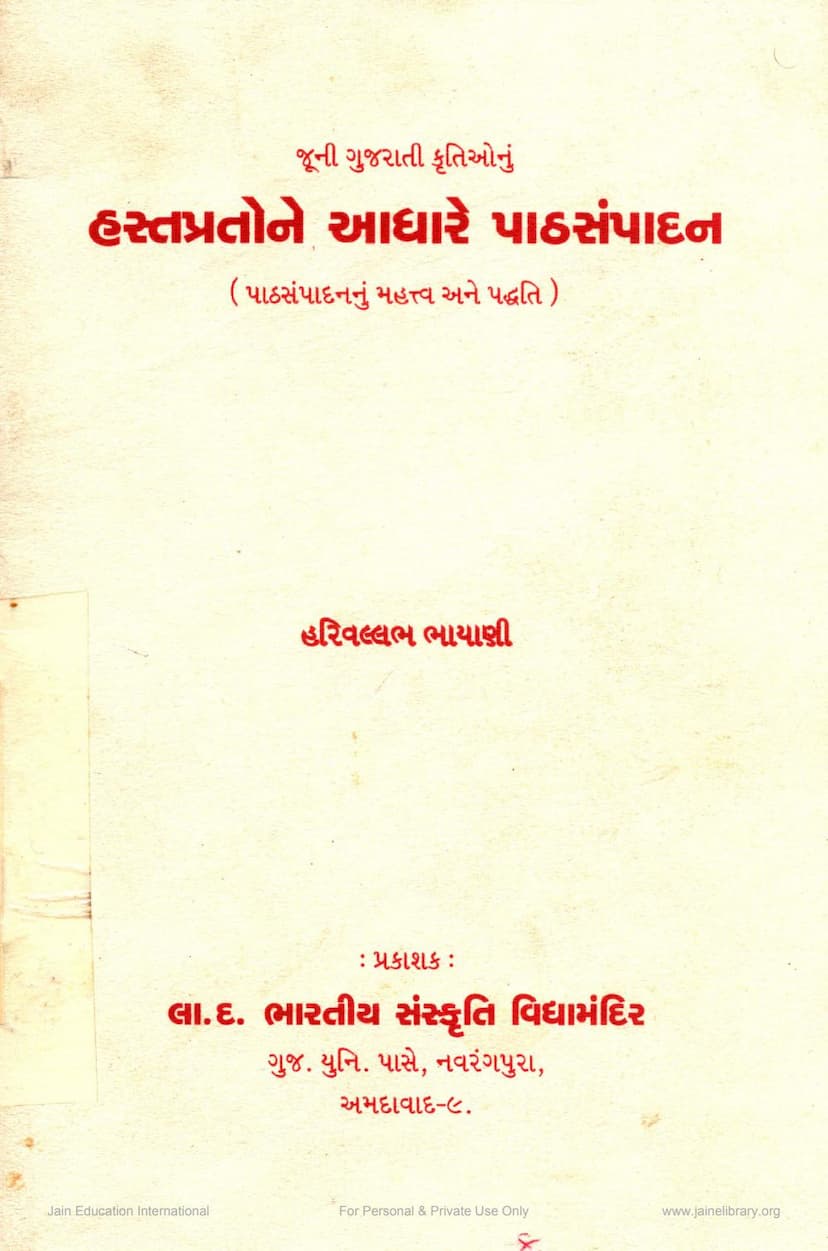Hastpratone Adhare Path Sampadan
Added to library: September 1, 2025

Summary
Here's a comprehensive summary of the Jain text "Hastpratone Adhare Path Sampadan" by H. C. Bhayani, based on the provided pages:
Book Title: Hastpratone Adhare Path Sampadan (Editing of Texts Based on Manuscripts) Author: H. C. Bhayani Publisher: L. D. Institute of Indology, Ahmedabad Catalog Link: https://jainqq.org/explore/005478/1
This book, first published in 1987 and reissued in 2007, serves as a crucial guide for anyone involved in the critical editing of ancient Gujarati literary works, particularly those based on manuscripts. It emphasizes the significance and methodology of textual criticism (pathasampadan) in understanding and preserving old literature.
Core Themes and Arguments:
- The Importance of Manuscripts: The book highlights that ancient texts, especially from medieval periods, exist primarily in the form of handwritten manuscripts. These manuscripts are the foundational material for any scholarly work on these texts.
- Challenges in Manuscript-Based Editing: Bhayani meticulously outlines the inherent difficulties and problems encountered when editing texts from manuscripts. These include:
- Transmission Errors: Copies made over centuries by scribes (lahiyos) introduce errors due to carelessness, ignorance, misinterpretations of the original script, or deliberate emendations by readers.
- Loss and Degradation: Manuscripts are susceptible to damage, loss, and destruction over time due to various factors like political turmoil, invasions, and natural decay.
- Varied Manuscript Traditions: A single work often exists in multiple manuscript traditions, with each tradition exhibiting variations in readings, spellings, vocabulary, and even entire sections.
- Absence of Original Manuscripts: Often, the original manuscript created by the author is lost, and only later copies, sometimes the fifth or tenth generation, are available.
- Inconsistent Orthography (Spelling): Medieval Gujarati manuscripts exhibit extreme inconsistency in spelling. The same word can be spelled differently within the same manuscript, and across different manuscripts. Bhayani lists numerous examples of these inconsistencies (e.g., variations in vowels, nasals, sibilants, consonants).
- Textual Variations (Pathabhed): Beyond spelling, there are variations in word choices, grammatical forms, addition or omission of words, and even entire lines or couplets.
- The Role of Meter (Chhand) in Textual Criticism: While in some languages like Sanskrit, meter is a strong tool for textual criticism, Bhayani notes its limited utility in medieval Gujarati poetry due to the use of more flexible native meters. However, it still plays a role in understanding the intended form.
- The Need for a Scientific Methodology: The book strongly advocates for a scientific and systematic approach to textual criticism. It criticizes earlier practices of simply printing the manuscript that came to hand, or making arbitrary emendations without proper justification.
- Principles of Scholarly Editing (Shastriya Pathasampadan): Bhayani lays out a methodical approach for textual criticism:
- Acquire All Available Manuscripts: Gather all known manuscripts of the text through catalogues and research.
- Establish Genetic Relationships (Vargikaran/Gotravibhag): Compare manuscripts to group them based on similarities in readings, errors, and scribal features. This helps identify different textual traditions.
- Determine Reliability and Antiquity: Within each group, identify the oldest and most reliable manuscripts. Criteria for this include the date of transcription, spelling, language, vocabulary, meter (if applicable), writing style, and consistency with other works by the same author.
- Critical Text Selection: Compare the readings from the selected manuscripts and establish a critical text that aims to be closest to the original author's work. Important variants should also be noted.
- Provide Critical Commentary: Explain the rationale behind specific textual choices, especially for difficult or contested passages.
- Beyond Textual Criticism: Bhayani emphasizes that textual criticism is only the beginning of literary research. Once a reliable text is established, further research is needed to determine the author, date of composition, historical context, and cultural significance of the work. He discusses the complexities of authorial attribution and dating, citing examples from Sanskrit and Gujarati literature.
- Critique of Existing Editions: A significant portion of the book involves a critical review of existing scholarly editions of medieval Gujarati works like Akho's "Anubhavbindu," Dehalo's "Abhinav-Unzanu," and Bhim's "Sadayavats-Vir-Praband." Bhayani points out their strengths and weaknesses, particularly regarding their editorial methodology, handling of variants, and understanding of meter. He highlights instances where editors have made arbitrary changes, failed to use available manuscripts, or neglected critical analysis.
- The Unique Challenges of Gujarati Texts: Bhayani specifically addresses the peculiarities of editing medieval Gujarati texts. He notes that due to the rapid evolution of the language and inconsistent scribal practices, it is often more challenging to reconstruct the original form of a Gujarati text compared to Sanskrit or Prakrit texts. He advocates for a tailored approach to manuscript collation and variant recording for Gujarati works.
Key Takeaways:
- "Hastpratone Adhare Path Sampadan" is a foundational text for anyone engaging with the critical study of old Gujarati literature.
- It underscores that a rigorous, scientific methodology is essential for accurate textual reconstruction.
- The book highlights the inherent difficulties posed by the nature of manuscripts and the transmission of texts.
- Bhayani's work serves as both a theoretical guide and a practical demonstration through his critical analyses of existing editions.
- It emphasizes that the goal is not just to produce an edition, but to facilitate deeper scholarly understanding of the literature and its historical context.
In essence, H. C. Bhayani's "Hastpratone Adhare Path Sampadan" is a comprehensive and authoritative work that demystifies the complex process of textual criticism for medieval Gujarati literature, providing scholars with the necessary tools and critical perspective to approach this challenging but vital field.